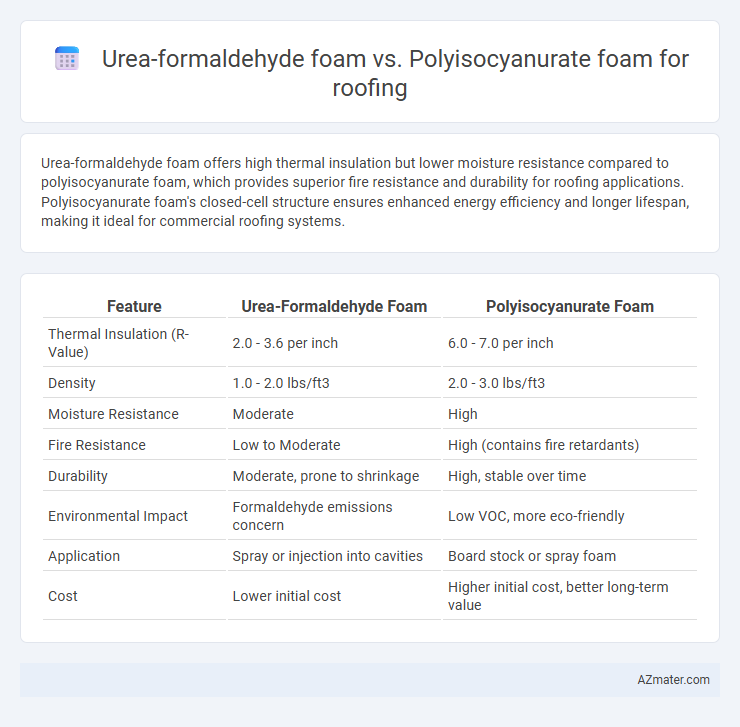Urea-formaldehyde foam offers high thermal insulation but lower moisture resistance compared to polyisocyanurate foam, which provides superior fire resistance and durability for roofing applications. Polyisocyanurate foam's closed-cell structure ensures enhanced energy efficiency and longer lifespan, making it ideal for commercial roofing systems.
Table of Comparison
| Feature | Urea-Formaldehyde Foam | Polyisocyanurate Foam |
|---|---|---|
| Thermal Insulation (R-Value) | 2.0 - 3.6 per inch | 6.0 - 7.0 per inch |
| Density | 1.0 - 2.0 lbs/ft3 | 2.0 - 3.0 lbs/ft3 |
| Moisture Resistance | Moderate | High |
| Fire Resistance | Low to Moderate | High (contains fire retardants) |
| Durability | Moderate, prone to shrinkage | High, stable over time |
| Environmental Impact | Formaldehyde emissions concern | Low VOC, more eco-friendly |
| Application | Spray or injection into cavities | Board stock or spray foam |
| Cost | Lower initial cost | Higher initial cost, better long-term value |
Introduction to Urea-formaldehyde and Polyisocyanurate Foams
Urea-formaldehyde foam (UFF) is a nitrogen-based thermosetting resin commonly used for insulation due to its low cost and efficient thermal resistance, typically featuring an R-value around 3.7 per inch. Polyisocyanurate (PIR) foam, a closed-cell plastic foam, offers superior thermal performance with R-values ranging from 6 to 6.5 per inch, making it highly effective for roofing insulation. Both materials differ in chemical composition and thermal properties, influencing their application in roofing systems and long-term durability.
Chemical Composition and Structure Comparison
Urea-formaldehyde foam consists primarily of a polymer formed by the reaction of urea and formaldehyde, creating a rigid, thermosetting resin with a high density of cross-linked bonds that provide moderate insulation and structural rigidity. Polyisocyanurate foam is produced through the polymerization of methylene diphenyl diisocyanate (MDI) and polyols, resulting in a closed-cell foam with a high concentration of isocyanurate rings that enhance thermal stability and fire resistance. The chemical composition of polyisocyanurate confers superior insulation R-values and better performance under elevated temperatures compared to the chemically simpler and less thermally stable urea-formaldehyde matrix.
Thermal Insulation Performance
Urea-formaldehyde foam (UFF) offers moderate thermal insulation with an R-value typically ranging from 3.6 to 4.0 per inch, making it less efficient compared to Polyisocyanurate foam (Polyiso), which exhibits higher thermal resistance with R-values between 6.0 and 6.5 per inch. Polyiso foam's closed-cell structure and superior thermal properties contribute to enhanced energy efficiency and reduced heat transfer in roofing applications. UFF may be more susceptible to moisture absorption and thermal degradation over time, whereas Polyiso maintains consistent insulation performance under various environmental conditions.
Moisture Resistance and Water Absorption
Urea-formaldehyde foam exhibits moderate moisture resistance but tends to absorb water more readily, which can compromise its insulation performance and structural integrity over time. Polyisocyanurate foam offers superior moisture resistance with significantly lower water absorption rates, making it more effective in preventing mold growth and maintaining thermal efficiency in roofing applications. The closed-cell structure of polyisocyanurate enhances its durability against water infiltration compared to the more porous urea-formaldehyde foam.
Fire Resistance and Safety Standards
Urea-formaldehyde foam roofing offers moderate fire resistance, typically meeting Class C fire ratings, but it may emit formaldehyde gases during combustion, raising safety concerns. Polyisocyanurate foam provides superior fire resistance with self-extinguishing properties and often achieves Class B or Class A fire ratings, complying with stricter building codes and safety standards. Polyisocyanurate's low smoke development and higher ignition temperature enhance overall roof safety compared to urea-formaldehyde foam systems.
Longevity and Durability in Roofing Applications
Urea-formaldehyde foam offers moderate longevity with vulnerability to moisture-related degradation, making it less durable for roofing applications compared to polyisocyanurate foam, which provides superior thermal insulation and resistance to water absorption. Polyisocyanurate foam's closed-cell structure enhances its lifespan by reducing the risk of mold and structural damage under varying weather conditions. Roofing systems utilizing polyisocyanurate foam typically exhibit extended service life and maintain structural integrity longer than those with urea-formaldehyde-based materials.
Environmental Impact and Sustainability
Urea-formaldehyde foam releases formaldehyde, a volatile organic compound (VOC) with potential health risks and contributes to indoor air pollution, while polyisocyanurate foam has lower VOC emissions and better thermal insulation, enhancing energy efficiency in roofing applications. Polyisocyanurate foam's closed-cell structure reduces thermal bridging and extends roof lifespan, minimizing material waste and environmental footprint. The sustainability of polyisocyanurate is further supported by its higher recycled content and greater fire resistance compared to urea-formaldehyde foam, making it a more eco-friendly choice for roofing systems.
Installation Methods and Practical Considerations
Urea-formaldehyde foam is installed through a two-component spray system that requires precise mixing and rapid application, offering excellent adhesion but with limited moisture resistance. Polyisocyanurate foam, applied as rigid boards or spray foam, demands a controlled temperature environment to ensure dimensional stability and provides superior thermal insulation and fire resistance. Practical considerations include urea-formaldehyde's susceptibility to degradation in high-humidity conditions, while polyisocyanurate's rigid boards require mechanical fastening, impacting installation speed and labor costs.
Cost Analysis: Material and Lifecycle Expenses
Urea-formaldehyde foam roofing generally offers lower initial material costs compared to polyisocyanurate foam, making it an attractive option for budget-conscious projects. Polyisocyanurate foam, while more expensive upfront, provides superior thermal insulation and durability, resulting in lower lifecycle expenses through energy savings and reduced maintenance. Evaluating total cost of ownership, polyisocyanurate foam often proves more cost-effective over time despite its higher initial price.
Suitability for Different Roofing Systems
Urea-formaldehyde foam offers excellent insulation and is ideal for low-slope roofing systems due to its lightweight and ease of application, but it may have limited moisture resistance compared to polyisocyanurate foam. Polyisocyanurate foam is highly suitable for steep-slope and commercial flat roofs because of its superior thermal resistance (high R-value) and enhanced moisture durability. Selecting between urea-formaldehyde and polyisocyanurate foam depends on the roofing system's exposure to weather, required insulation levels, and long-term performance expectations.

Infographic: Urea-formaldehyde foam vs Polyisocyanurate foam for Roofing
 azmater.com
azmater.com